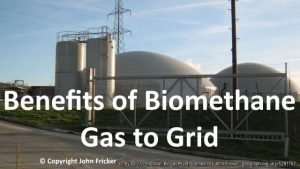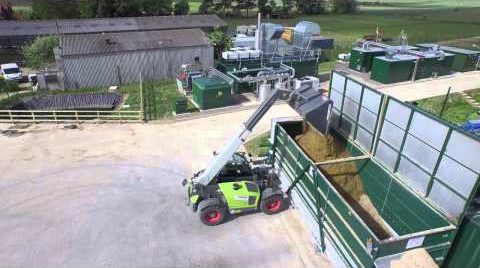In this article we will explain the advantages of biomethane gas to grid AD plants, but before we start on that, we thought we would be sure to bring all readers along with us by explaining what we mean by “gas to grid” anaerobic digestion plants.
The difference between a “gas to grid” biogas plant and a normal anaerobic digestion plant is that rather than use the biogas produced to make electricity, we take it a step further. We clean up, the raw biogas from the digester in a process we call “upgrading”.
 Upgrading is specifically when we purify the biogas (which contains carbon dioxide and impurities such as a little bit of hydrogen sulphide, and small “traces' of many other contaminants) to a specification very close to pure methane.
Upgrading is specifically when we purify the biogas (which contains carbon dioxide and impurities such as a little bit of hydrogen sulphide, and small “traces' of many other contaminants) to a specification very close to pure methane.
The specification of upgraded biogas is for a product gas which is suitable to be injected into the natural gas grid.
When this cleaned-up biogas has been upgraded in this manner, it is injected into the local gas grid. The result of that is that the AD plant is providing renewable gas for all of the local villages.
For on-farm biogas plant schemes there are various critical elements that all must come together before “gas to grid” anaerobic digestion plants can be built.
For gas to grid to be possible, site selection is most important. The site has to be somewhere in close proximity of a main gas pipe. That natural gas distribution pipe passing nearby, is essential to enable biomethane injection.
Go-ahead farmers that promote their own anaerobic digestion plant projects, are people who very quickly see the attractions of anaerobic digestion, not only for its :
Agronomic benefits but also from wider beneficial environmental impacts that it has the entire farm waste management process.
One important advantage of using gas grid for biomethane distribution is that the grid connects the production site of biomethane, which is usually in rural areas, with more densely populated areas. This enables the gas to reach new customers. Injected biomethane gas to grid can be used at any ratio with natural gas as vehicle fuel. via BioEnergy
Injecting biomethane produced through anaerobic digestion into the gas grid has an array of benefits. It is one of the most efficient uses of biogas and reduces our reliance on imported fossil gas, thus contributing to meeting the UK’s renewable energy and climate change targets whilst improving our energy security. Biomethane from AD could potentially deliver 10% of the UK’s domestic gas demand. via News
3 Advantages of Biomethane Gas to Grid AD Plants
1. Environmental Benefits for All to Enjoy
The integration of enriched biomethane into the national gas grid has several key environmental benefits.
The carbon dioxide released by combustion of biomethane does not increase atmospheric CO 2.
 This is because the same amount of CO 2 is produced from natural decomposition of the organic matter that initially creates the biomethane.
This is because the same amount of CO 2 is produced from natural decomposition of the organic matter that initially creates the biomethane.
In contrast, the CO 2 released from the burning of fossil fuels (such as natural gas) has been locked up in geological formations for millions of years, and would not otherwise be released to the atmosphere.
It is well worth exploring the use of biomethane as a road fuel, especially for water companies who need to transport sludge and waste water by road.
Biomethane is increasingly being used as a fuel for transport in the UK, where it is known as Bio-CNG.
Gas used in transport offers big environmental benefits – it is much cleaner than diesel and does not contribute to air pollution.
On a full lifecycle basis Bio-CNG provides a 72% reduction in CO2 emissions as well as being exceptionally clean, with ultra-low particulate emissions and ultra-low NOx emissions.
This is particularly important as air quality is becoming a big issue in towns and cities across the UK.
Waitrose is now using trucks that are fuelled on Bio-CNG to reduce its carbon footprint and help improve the quality of the air that its customers breathe.
Today, Waitrose is operating two dedicated CNG trucks and will have double digit numbers of dedicated CNG trucks in service before the end of the year.
Waitrose use the public access CNG refuelling station in Leyland, Lancashire, which is owned and operated by another company that CNG Services works closely with CNG Fuels Ltd (www.cngfuels.com).
2. Financial Benefit for the Transport Company/ User – CNG Fuel Costs Less
The experience of operating CNG trucks is very positive, with over 30% savings in pence per mile fuel cost compared to diesel. Also drivers report a positive driving experience, especially as the CNG vehicles are 50% quieter to operate, with a diesel-like performance.
In addition, they are simple to refuel, with no risk or spillage and no personal protective equipment needed.
Most importantly, the vehicles are not constrained by range vehicles in service are currently doing 4,000 – 5,000 km/week. via waterprojectsonline.com
The benefits of gas to grid anaerobic digestion are spelt out in a new video from renewable energy firm EnviTec Biogas UK. The video (watch it below!) shows the company’s first UK gas to grid plant, at Icknield Farm, in Wallingford, Oxfordshire, has been produced as a case study.
3. The Company that Makes the Biomethane Makes a Profit
Finally, the company which makes our first tow benefits possible also makes a profit, which is the most essential benefit if you think about it. Otherwise non of the other benefits will be possible…
To illustrate that at least one biomethane producer company is making a profit we have included the case study which follows:
Case Study – UK Biomethane Gas to Grid plant, at Icknield Farm, in Wallingford, Oxfordshire
From first meeting with Guy Hildreth, the landowner, through to having a plant that was up and running was only about 15 months.
It was remarkably quick we had planning within five months and we started construction shortly thereafter. It took us only six months of construction to get a working plant and injecting gas into the natural gas grid.
The expected payback on the project rather depends upon gas prices and various other bits and pieces but you would normally expect somewhere between seven to ten years on a project like this.
The reason for selecting EnviTec Biogas UK, was that:
- first of all they're a large and very solvent company
- the second thing was that they had done gas to grid before.
EnviTec Biogas UK had expertise in it. These are complicated plants. There's a lot of it that can go wrong. So, EnviTec Biogas UK really valued the ability to appoint just one turnkey provider. A provider that was able to give EnviTec Biogas UK. Gaining a solution for the entire project was a major advantage.
Our ideal-world offering, giving us what in our view was the biggest benefit, was to partner with a company that had not just built one, but also many other plants of this type before.
EnviTec Biogas UK has done just that, and was able to provide ongoing support. Support, both in terms of maintenance and in terms of the biology and EnviTec Biogas UK have that capability here in the UK.
They have a biological support group, and in addition they have a service group.
If something should ever go wrong EnviTec Biogas UK has a service contract. I pick up the phone and they're here within a few hours.
What we're doing here is we are essentially converting organic matter to gas with a high calorific (energy) content. At our Icknield Farm anaerobic digestion plant, in Wallingford, Oxfordshire, it's all farm material which is used as the fertiliser.
EnviTec Biogas UK has operatives at the site who accept:
- manure slurries and purpose grown energy crops, and
- crop residues.
Biomethane Gas to Grid Profits Pay-Back the Investment
From the biomethane which we can then inject into the gas grid, we effectively get two sources of income:
- Renewable Heat Incentive (RHI) payments
- Sale of the biomethane gas produced.
 That's about 300 cubic meters of biomethane per hour, which is sufficient to power somewhere between two and three thousand local homes.
That's about 300 cubic meters of biomethane per hour, which is sufficient to power somewhere between two and three thousand local homes.
The ultimate ambition is to scale that up to possibly double that as part of the UK government's subsidy scheme.
Within their “renewable heat incentive” EnviTec Biogas UK are required to meet sustainability criteria to show that the energy that they are producing is from a sustainable source.
That should be a simple process, actually creating a significant reduction in the greenhouse gas emissions. This must be done for the whole process from start to finish.
Advantages of Gas to Grid AD Plants – Conclusion
In this article we have explained how gas to grid AD plants benefit all of us, by providing renewable fuel which is far cleaner burning than present transport fuels (diesel or petrol/ gasoline). They benefit the vehicle owner by being cheaper at current UK tax rates, and they also benefit the biomethane producer that makes a business profit.
However, we have still only scratched the surface of the benefits of gas to grid AD plants.
One of the great things about AD as a technology is that it produces its product in this case biomethane 24/7 at a constant level.
That sets it apart from most of the other renewable energy technologies. Digesters can be very reliable for producing constant production levels and can be run without large fluctuations in output due to seasonal and daily weather patterns.
They also provide a waste management method for farm waste and provide good jobs in many locations, of which many of these jobs are created in rural areas.
The EnviTec Biogas video shown above, is also found on Youtube. Visit EnviTec Biogas
Note on Biogas Calorific Value:
Most biogas has a calorific value slightly below that of natural gas, and it needs to be augmented by the addition of a small amount of a higher calorific value gas. The gas used is LPG gas. The Calor Gas company provides this service here.




